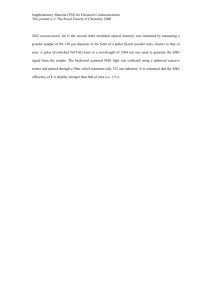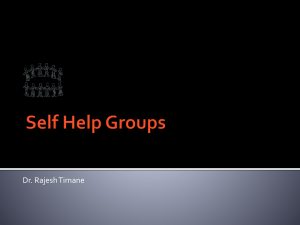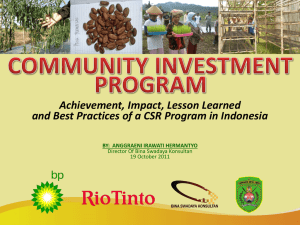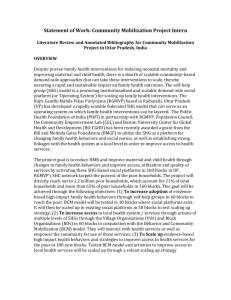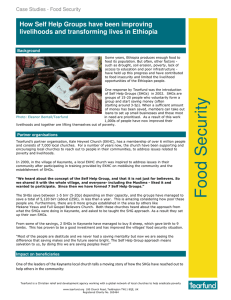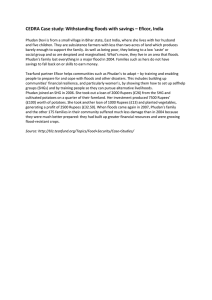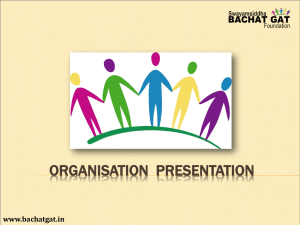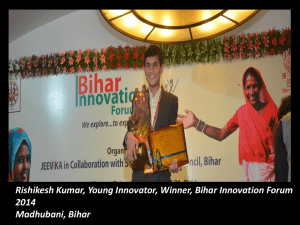Partnerships for change: a cost benefit analysis of exeCuTIve SuMMAry
advertisement
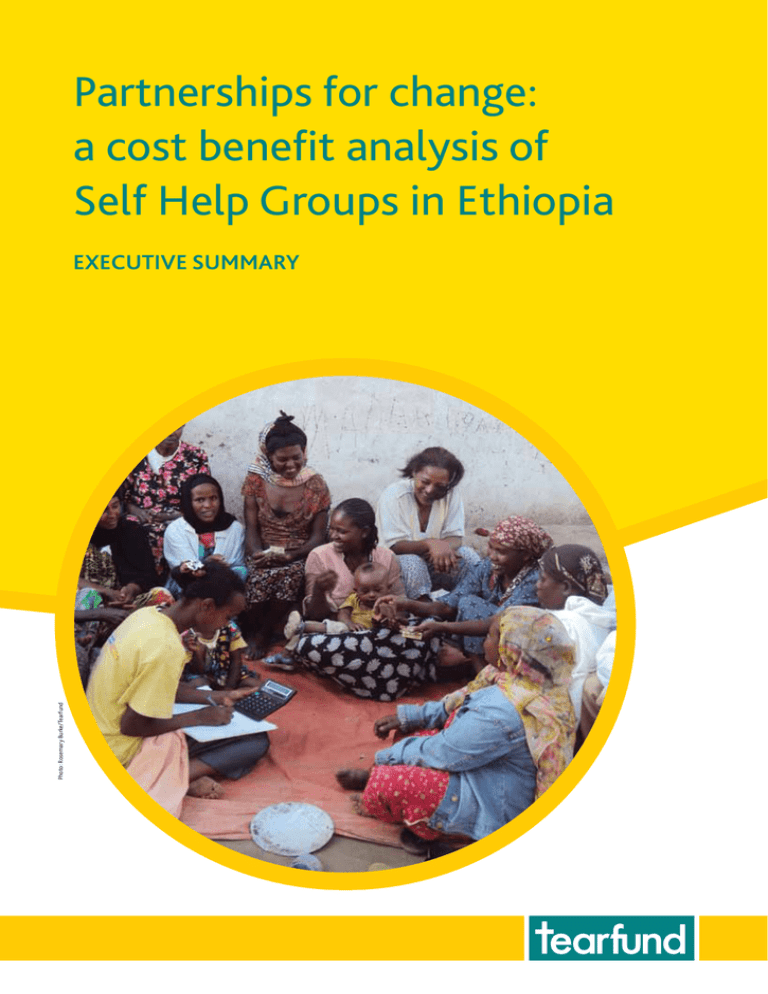
Partnerships for change: a cost benefit analysis of Self Help Groups in Ethiopia Photo: Rosemary Burke/Tearfund Executive summary Introduction Ethiopia ranks 174 out of 187 countries on the Human Development Index (HDI).1 Some 39 per cent of the population still live below the poverty line, surviving on $1.25 per day, and 77.6 per cent live on less than $2 per day. Photo: Keith Etherington/Tearfund The country suffers from frequent droughts and floods that result in significant loss of harvest and livestock. These hazards put ten to 15 per cent of the population at risk of food insecurity or malnutrition, leaving them in need of emergency food aid. ‘Initially we were “cursed” but now we are people with vision. We were beggars: now we give money to other beggars and they are now working. We started in June 2009 from a group of street boys and beggars. We started to save 25c, 1 Birr, 5 Birr and now 10 Birr [£0.35 / €0.41] per week. We trade peppers, sugar and salt, and make gabis [traditional clothing]. We have now 5,000 Birr [£178 / €209] and are giving loans to neighbours at ten per cent interest. I want to thank the project workers who have worked with us day and night to reach this level.’ Mekuria, a member of the Hope for Tomorrow Self Help Group in Fincha town costs of taking the approach to scale: about £20 / €24 per person is required for support in SHG formation (in the first two to three years), and £30 / €36 per person has been required for longer-term institutional support to establish SHG association infrastructure, which then sustains the SHGs and their development. Costs are likely to increase slightly in the future to improve the overall quality of SHG development. In 2002, Tearfund helped introduce the Self Help Group (SHG) approach to Ethiopia. The first five SHGs were started by 100 women in Nazareth (also known as Adama), a town 55 miles east of Addis Ababa in central Ethiopia. Today, the number of SHGs in programmes funded by Tearfund has increased to more than 12,000 across Ethiopia, impacting more than 1 million people. The programme has cost an average of about £50 / €60 per SHG member, which equates to about £10 / €12 per beneficiary. These figures include the full The aim of this study is to document developments in SHGs which Tearfund is supporting in Ethiopia. Specifically, a cost benefit analysis (CBA) approach has been used to complement qualitative evidence on outcomes with quantitative evidence, to demonstrate the value for money of such an approach. The figures coming out of this analysis are some of the highest in recent literature using CBA to assess impact. They highlight the fact that SHGs are bringing transformational change. 1 The HDI is a summary measure for assessing long-term progress in three basic dimensions of human development: a long and healthy life, access to knowledge and a decent standard of living. 2 Partnerships for change: a cost benefit analysis of Self Help Groups in Ethiopia – Executive summary The Self Help Group approach SHGs are groups of 15 to 20 people, usually chosen from the poorest sectors of the community. Facilitators help each group to develop healthy relationships, set up a saving scheme and establish by-laws on how they will operate. Group members save a small amount each week, usually starting at about £0.02 / €0.024. In time, members can start to take out small loans that are repaid with interest over an agreed time period. Gradually, as the SHG’s capital grows, larger loans can be made. Initially, loans are taken out to pay for schooling, healthcare costs and income generation. Later on, they are predominantly used for income generation. As well as being savings and credit schemes, the SHGs are sanctuaries where members can come and discuss their problems. Their confidence grows and they have become drivers of change in their own lives and in their communities. For example, groups have lobbied local government officials, built kindergartens, advocated for women’s rights, supported orphans in their communities, rebuilt houses for widows, dug wells or terraced land to prevent soil erosion. Once eight to 12 SHGs have been established in an area and they have reached a certain level of maturity, they each elect two members to join a Cluster Level Association (CLA). The CLA is empowered to take responsibility for setting up new SHGs and developing existing ones. When ten or more CLAs have been formed and become mature, a Federal Level Association (FLA) is formed from elected SHG members. This FLA is then registered with the government. The areas selected for this study are in two regional states, namely Oromiya and the Southern Nations, Nationalities and Peoples’ Region (SNNPR). The analysis focused on six programmes, with different project foci: n n n n Integrated Urban Development – Nazareth and Hawassa Food Security Programme – Wolaita Project Gilgal Church Mobilisation – Sidama and Wolaita HIV/AIDS Programme – Fincha and Shambu (one programme), Leku Photo: Eleanor Bentall/Tearfund ‘Self Help Groups come together to do what they cannot do individually.’ Tearfund, Horn of Africa Regional Office Annual Report 2011/2 Partnerships for change: a cost benefit analysis of Self Help Groups in Ethiopia – Executive summary 3 Methodology Preparation n n n A two-day workshop was carried out with partner agency staff to familiarise them with the cost benefit analysis (CBA) approach and to develop criteria for selecting study areas. n n –Market penetration model: The second CBA takes the full programme data, and models the costs and benefits until the programme reaches market penetration, based on an annual average growth rate of 20 per cent. –Donor-funded model: Once the first group of SHGs reaches ‘graduation’, they are capable of sustaining the growth of new SHGs themselves, internally. Therefore, the model is run again for the whole programme, but this time accounting only for external funding in the first ten years. Before the main research was carried out, the analytical method was field-tested with at least two SHGs and one control group at each study location, to identify and resolve any issues with its implementation. While a substantial number of focus group discussions were undertaken with SHG and control communities, these represent only a small proportion of the total number. So they cannot be considered to be statistically representative of all SHGs. Having said this, the findings do echo the experience of the programme team working across the SHG community. The research specifically targeted ‘average’ SHGs, with the aim of getting a reasonable and fair approximation of the SHG programme’s impact. Data was gathered using participatory approaches through focus group discussion (see table 1). Data analysis n Three models were developed to analyse the costs 2 and benefits over the project lifetime: –Individual case model: The first CBA looks at an individual SHG with 17 members (average size), and estimates the costs and benefits over a 20‑year lifetime. SHGs which were three years old and above were prioritised for focus group discussions (FGDs) (as longer-standing members could better document progressive change). A total of 544 SHG members participated in 65 FGDs. Control groups were also selected, comprising community members who lived in the same area but who were not involved in the SHGs, to enable comparisons between the two groups. A total of 324 people were interviewed through 34 control FGDs. Field work n All benefits are measured on a per capita basis, using a weighted average. Evidence from the field work was evaluated according to the six programme areas described above. Control group data was compared with SHG group data for each programme area, and summarised according to the main areas of benefit. Table 1: Overview of SHGs participating in CBA Nature of project focus Integrated urban development Project identifier Nazareth Hawassa Food security Church Mobilisation HIV Wolaita Gilgal Leku Fincha and Shambu Years of existence 10 9 7 4.5 4.5 4.5 No. of SHGs 411 192 163 145 78 107 No. of SHG members 6,620 3,040 2,388 2,465 1,560 1,721 No. of SHG members interviewed 80 58 72 116 136 82 No. of control group members interviewed 40 30 75 46 59 74 2 Net benefits are discounted at 10%. Discounting is used to reflect the time value of money – in other words, a dollar today is valued more highly than a dollar in the future. 4 Partnerships for change: a cost benefit analysis of Self Help Groups in Ethiopia – Executive summary Assessing SHGs’ impact The SHGs have had far-reaching impacts on their members. Relationships are at the core of this model and critical to the programme’s success. Perhaps the most significant outcome of the SHGs is a social one: SHG members talk consistently about increased confidence and skills, the ability to relate better to one another, the sense of support that they feel from one another, empowerment, dignity etc. n Consistently, SHG members experience a cycle of ‘asset accumulation’. As a result of the social capital that is built at the heart of the programme, SHG households are diversifying their income, pooling resources to help those in need and initiating change in their communities. As a result, food intake is more frequent for SHG households (three plus meals per day) and diets are more nutritious. These households are sending their children to school and now paying for private education and healthcare. Their asset base is growing and gives them the resilience to cope with bad times without their having to sell off assets at reduced prices (‘stress sales’). Both women and men are being empowered to engage in issues that affect them and become drivers for change in their communities. Environmental awareness is high, driving initiatives such as tree-planting, more widespread composting and sustainable agricultural practices, as well as sanitation projects. Crucially, SHGs are self-sustaining and self-replicating. Some ongoing benefits were not monetized for this analysis, though there impacts were significant, including better healthcare, improved ‘safety nets’ for poor people and better quality of life. The valuation of capital formation – in other words, the change in the asset base that has occurred as a result of improved income and a stronger culture of saving. This accumulation results in tangible gains: people are eating more and better food (which has linkages with better educational attainment and higher incomes later in life); they have a ‘safety net’ to fall back on in hard times; and they can help others around them. They are spending more on higherquality healthcare and education. This is not modelled as it is an outcome of increased income (which is already reflected in the valuation of quantifiable benefits). But it does indicate the transformational change that is occurring in these communities. For every British pound sterling or Euro spent, there is a return of between 58 and 173 pounds or Euros in benefits. The benefit-to-cost ratios range between 58:1 and 173:1 for individual programmes when the costs of SHGs are offset against the quantifiable benefits. This rises to a return of more than 210 pounds and Euros in benefits (210:1 and above), when analysing self help group growth that becomes self-sustaining after ten years of donor funding (See table 2). The analysis collected data on the following: n The valuation of quantifiable benefits that have accrued as a result of the SHGs, specifically: –increases in income –higher school attendance –access to low-interest loans –fewer stress sales. Clearly, the SHG programme is delivering substantial returns on investment. These figures are some of the highest in recent literature using cost benefit analysis to assess impact. And there is no doubt that the benefits quantified here understate the transformational impact felt in these communities. Table 2: Baseline benefit-to-cost ratios (BCRs) BCRs Nazareth Hawassa Gilgal Wolaita Fincha and Shambu Leku Scenario 1: Individual SHG 115:1 76:1 116:1 58:1 165:1 173:1 Scenario 2: Full programme 140:1 97:1 112:1 70:1 130:1 124:1 Scenario 3: Donor-funded 320:1 210:1 400:1 238:1 285:1 222:1 Partnerships for change: a cost benefit analysis of Self Help Groups in Ethiopia – Executive summary 5 Conclusions The findings above support the following conclusions: n n n n n n n 6 ’I was one of the first 100 ladies to start an SHG in 2002. I had a mini shop with capital of 300 Birr [£11 / €13] and I was not initially interested in the approach as it did not offer me the capital I was looking for. But my neighbours convinced me to join and I started saving 2 Birr a week. When I understood the approach, I started saving 5 Birr a week. I took a loan for 150 Birr, then 500 Birr and now 20,000 Birr [£713 / €837]. With the loan, I bought a refrigerator and sell cold drinks. I used one of my early loans to buy and sell charcoal, and then used the profit from that to manufacture and sell smokeless stoves. The training from the project helps us to utilise our resources efficiently and effectively.’ The SHG model delivers very high returns and is demonstrating transformational change. In addition, returns on donor investment are very high. Because the SHG grows organically and the first groups develop and replicate themselves in new SHGs, growth in returns on initial donor investment is exponential. Cost-effectiveness is driven by high impact and low costs. The basis of the model is community empowerment, which fosters longterm commitment and sustainability. The costs of realising SHG benefits are low and over time can be largely self funded. SHG expansion happens organically and can quickly go to scale. The growth rate is high among all of the SHG programmes, even in early years, averaging about 20 per cent each year. Mobilisation via the church network has been a critical factor in taking the programme to scale; a strong network of community-based faith groups facilitates penetration. The SHG model reduces religious and ethnic tensions. SHG members are selected from among the poorest people in a community, regardless of their religious beliefs or ethnicity. As communities work together through the SHGs, pre-existing tensions between religious and ethnic groups ease, giving way to supportive relationships. Zenaga, SHG member in Nazareth town n n The SHG model has the potential to make a significant contribution to the Ethiopian government’s plans for development and transformation. The SHG model has substantial benefits for women and girls. Focus group discussions report consistently that women involved in SHGs have increased confidence and decision-making power. Several of the programmes have raised awareness of certain issues, leading to a reduction in the incidence of female genital cutting (FGC), for example. Girls are being sent to school for the first time. WASH interventions are decreasing the time it takes to collect water, as well as creating better sanitation facilities, both of which can have a significant impact on girls. The SHG model could complement other programmes, such as the Productive Safety Net Programme (PSNP). The SHG model delivers both humanitarian and development gains. The SHG programme was conceived as a development programme aimed at transforming people’s lives holistically. It empowers people to cope better with all their priority needs, droughts and other shocks. SHGs members become more resilient, thanks not only to contingency funds for emergencies but to livelihood diversification and soil and water conservation activities, even within the first few years of the SHGs being set up. However, to deliver these gains, the SHG model requires a shift in mindsets. As seen, the success of the SHG approach depends on a long-term commitment. (Typically, development projects tend to last three to five years.) The approach is also very dependent on community empowerment. It requires a shift from a resource- and handouts-driven approach for assetbased development, to an approach that is focused on long-term transformation. Partnerships for change: a cost benefit analysis of Self Help Groups in Ethiopia – Executive summary Recommendations 1 Increase investment in SHGs across Ethiopia. The findings show high value for money, are exceptional, and demonstrate transformational change in the communities where the SHG programme exists. For example: the SHG approach could be used to support those benefiting from the Productive Safety Net Programme to develop sustainable livelihoods; likewise, SHGs could benefit significantly from appropriate access to external finance through loans from Micro Finance Institutions. 2 Conduct further qualitative research to identify the key success factors with this model. SHGs are not a new concept and yet little research exists to understand some of the key differentiating factors that enable them to deliver such strong gains as indicated in this programme. This should include improving collection of systematic data on impacts of the SHG programme, especially those that could not be quantified here such as health impacts, HIV/AIDS impacts, and WASH impacts. 4 Institutional and other donors should look at the applicability and replicability of this model and potential areas for expansion of the programme. The initial donor investment can deliver very high value for money within Ethiopia and other countries. However, it is critical that donors also understand that this process requires longer-term support than current standards of practice and funding cycles, and it needs to empower people to do things for themselves rather than have things done for them. 5 Government policies need to support the expansion of the SHG programme. Policy and practice need to support the healthy development of SHGs, CLAs, and FLAs so that they can access appropriate services and opportunities at the right time. Further research should be undertaken to determine specific policy and practice changes needed both in Ethiopia and other countries this approach is expanded to. Photo: Eleanor Bentall/Tearfund These recommendations are relevant to all those who currently support SHGs or wish to invest in them as a cost-effective community development approach. 3 Investigate models for greater harmonization of the approach both at levels of implementing organisation and donors. The SHGs follow an approach that does not provide external capital to the SHG in order to start, and this was identified by SHG members and those working on the SHG programme as a critical success factor. This approach is not common across all similar programmes, and greater coherence is needed. Partnerships for change: a cost benefit analysis of Self Help Groups in Ethiopia – Executive summary 7 Acknowledgements This cost benefit analysis has been jointly funded by Tearfund (UK) and Tearfund Ireland. Without this partnership, this CBA would not have been possible. The study team would like to thank the tireless efforts of our local partner staff. The assessment was wide in scope and required a truly joint effort. Most of all, we would like to acknowledge all those community members who have become part of the Self Help Group ‘family’. The transformational change documented in this report is entirely due to their commitment to the process. Photo: Keith Etherington/Tearfund Without the tireless efforts of Tearfund partners in both supporting the SHG work and this CBA this report could not have been written and so we particularly thank Ethiopian Kale Heywet Church, Wolaitta Kale Heywet Church – Terepeza Development Association, Ethiopian Guenet Church Development and Welfare Organisation and Meserete Kristos Church Relief and Development Association for their dedication and support. We would also like to thank Oenone Chadburn, Jo Khinmaung, Joel Hafvenstein and Donald Mavunduse at Tearfund (UK) for their review and ongoing support of this work, as well as Reuben Coulter and Markus Köker at Tearfund Ireland for their support and feedback. We appreciate the funding and support from the following donors: n Dublin City Council n Irish Aid n Tear Netherlands n Tearfund Wales n The Big Give n The ICCO alliance n The Jerusalem Trust n The John Stott Memorial Fund, Kindernothilfe n The Presbyterian Church of Ireland n World Relief Canada (with support from Canadian Food Grains Bank) For the full report, visit: www.tearfund.org/partnershipsforchange © Tearfund Horn of Africa Regional Office, Tearfund (UK) and Tearfund Ireland – October 2013 Courtenay Cabot Venton (consultant and lead author), Ephraim Tsegay, Keith Etherington, Mulugeta Dejenu, Tadesse Dadi, (all contributors fromTearfund Ethiopia). Tearfund is a Christian relief and development agency working with a global network of local churches to help eradicate poverty. 31089 – (1013) Tearfund (UK) – www.tearfund.org 100 Church Road, Teddington, TW11 8QE, United Kingdom Tel: +44 (0)20 8977 9144 Registered Charity No. 265464 (England and Wales) Registered Charity No. SC037624 (Scotland) Tearfund Ireland – www.tearfund.ie Ulysses House, 22-24 Foley Street, Dublin 1, Ireland Tel: +353 (0)1 878 3200 Charity number: CHY 8600
